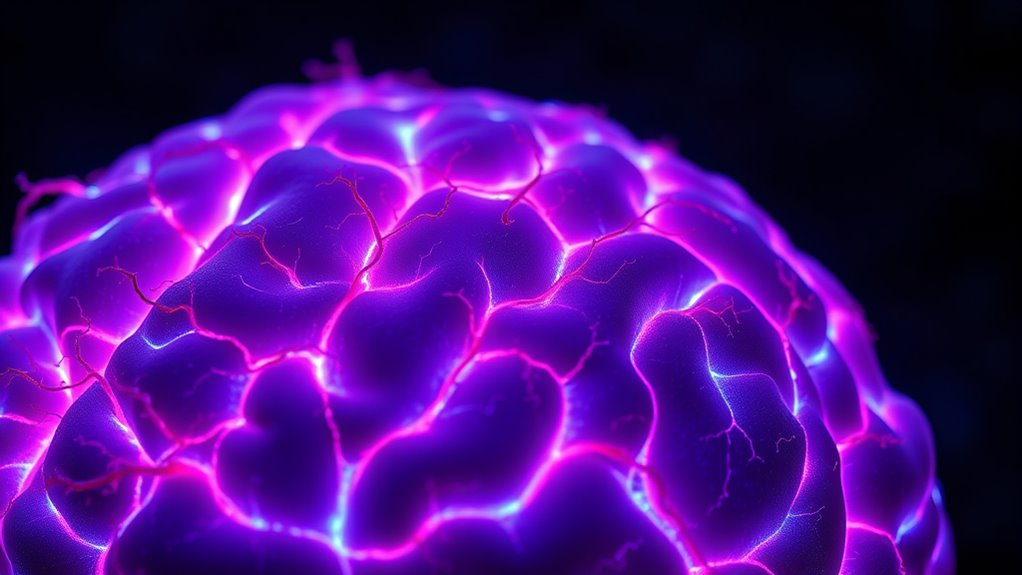CGRP is a key player in migraine development, working as a neuropeptide that causes blood vessels to dilate and promotes inflammation around nerves. During a migraine, stress or hormonal changes trigger its release from hyperactive nerve endings, leading to increased sensitivity, pain, and throbbing sensations. It also amplifies signals related to inflammation and blood flow, making symptoms worse. Keep exploring to uncover more about how this powerful molecule contributes to migraines.
Key Takeaways
- CGRP is released from trigeminal nerve terminals during migraines, contributing to pain and neurogenic inflammation.
- It promotes vasodilation of meningeal blood vessels, increasing tissue swelling and nerve pressure.
- CGRP amplifies neuronal excitability by increasing excitatory neurotransmitter release, enhancing migraine sensitivity.
- Genetic variations affecting CGRP production or receptor function can influence individual migraine susceptibility.
- Targeted therapies blocking CGRP or its receptor effectively reduce migraine frequency and severity.
Understanding Migraine and Its Impact
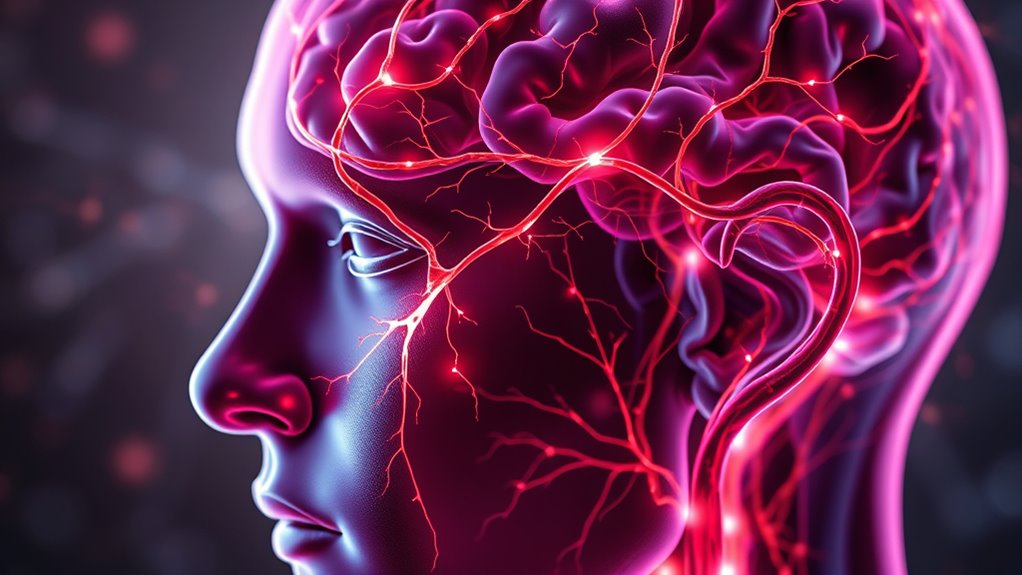
Migraine is a neurological condition that substantially affects millions of people worldwide, often disrupting daily life and productivity. You can manage its impact by making lifestyle modifications, such as maintaining regular sleep patterns, staying hydrated, and reducing stress. Identifying and avoiding dietary triggers, like caffeine, alcohol, and certain processed foods, also plays a pivotal role in prevention. These changes help minimize the frequency and severity of attacks, empowering you to regain control. Understanding how migraines affect your body encourages proactive steps to reduce triggers and improve your quality of life. While migraines can be debilitating, adopting these strategies can markedly lessen their impact, helping you stay productive and engaged. Recognizing the importance of lifestyle and diet is essential in managing this condition effectively.
The Biological Nature of CGRP
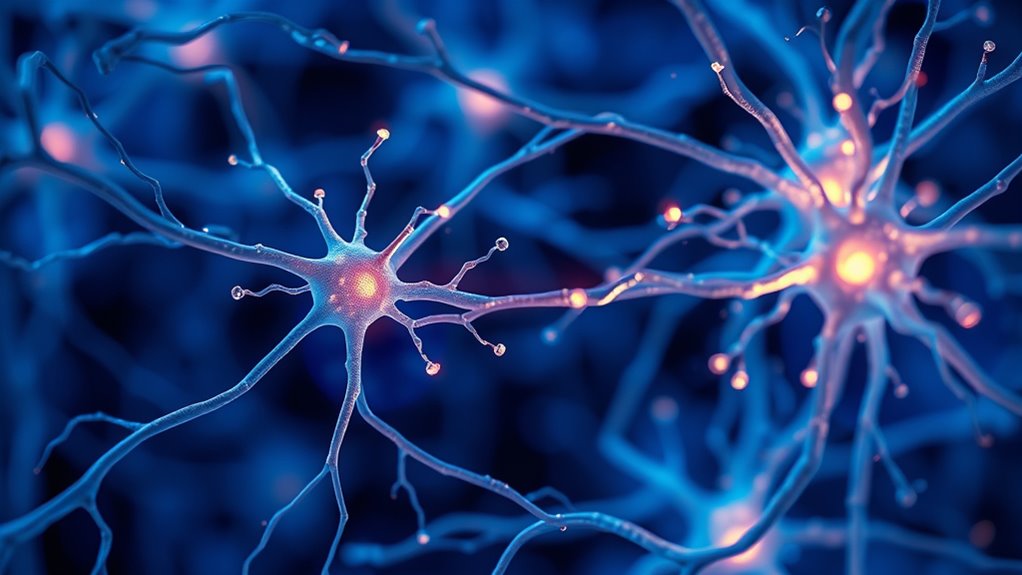
You should understand that CGRP, or calcitonin gene-related peptide, exists in different forms with distinct roles. It primarily functions as a signaling molecule in your nervous system, influencing pain transmission and blood vessel dilation. Recognizing its structure and types helps explain how CGRP contributes to migraine development. Understanding the biological nature of CGRP can provide context for how everyday products and lifestyle choices may impact overall health and migraine management.
CGRP Structure and Types
Calcitonin gene-related peptide (CGRP) is a small, highly conserved neuropeptide composed of 37 amino acids, playing a essential role in pain transmission and vasodilation. It exists mainly in two cgrp isoforms: alpha and beta, which differ slightly in peptide structure and tissue distribution. These isoforms influence how CGRP interacts with receptors and functions within the body. The peptide structure features a ring formed by a disulfide bond, crucial for receptor binding. Here’s a quick overview:
| Isoform | Tissue Distribution | Peptide Structure Feature |
|---|---|---|
| Alpha | Nervous system | Disulfide ring |
| Beta | Peripheral tissues | Similar peptide backbone |
| Variants | Minor amino acid differences | Impact receptor affinity |
| Function | Pain, vasodilation | Structural stability |
| Distribution | CNS and PNS | Peptide conformation |
Understanding these nuances helps clarify CGRP’s biological roles. Additionally, the stability of the peptide’s structure is essential for its biological activity, which influences its role in various physiological processes. Moreover, the conformational stability of CGRP is vital for its effective receptor interaction and subsequent physiological effects.
Function in Nervous System
CGRP plays a vital role in the nervous system by acting as a potent neurotransmitter and neuromodulator. You’ll find it influencing neural modulation by affecting how neurons communicate and respond to stimuli. Its presence impacts neurotransmitter dynamics, helping to regulate pain signals and vascular responses. When released, CGRP enhances signal transmission in pain pathways, especially during migraines. It also participates in modulating blood vessel dilation, which can amplify neurogenic inflammation. This dual role in neural modulation and neurotransmitter activity makes CGRP essential for maintaining neural balance. Understanding how CGRP influences these processes helps explain its involvement in migraine attacks and highlights its significance in overall nervous system function. Additionally, its involvement in vascular responses underscores the importance of neurovascular interactions, which are crucial for vascular regulation in migraine pathophysiology. The neurovascular coupling process, where neural activity influences blood flow, is also significantly impacted by CGRP activity, further emphasizing its role in migraine development.
How CGRP Is Released During Migraine Attacks
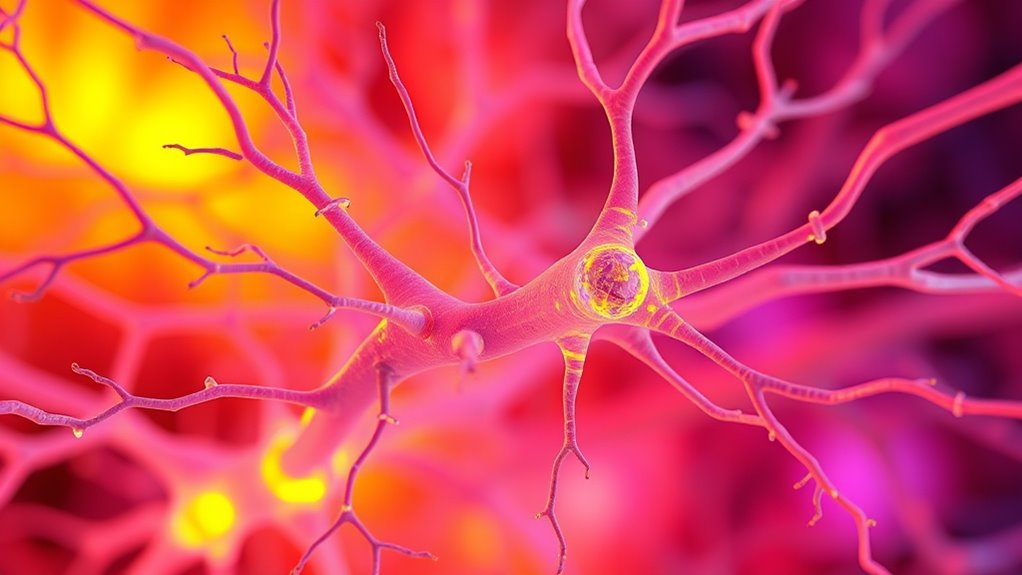
During a migraine attack, nerve cells in the trigeminal pathway become hyperactive, prompting the release of calcitonin gene-related peptide (CGRP). The cgrp release mechanisms involve nerve terminals responding to migraine trigger factors like stress, hormonal changes, or certain foods. When these factors activate trigeminal nerves, they release CGRP into the surrounding tissues. This neuropeptide then signals nearby blood vessels and nerve cells, amplifying the pain response. The release process is influenced by various triggers that sensitize neurons and increase their excitability. As CGRP is released, it plays a key role in propagating migraine symptoms. Understanding the mechanisms of neuropeptide release helps explain how specific triggers set off the cascade leading to a migraine attack.
Vasodilation and Its Role in Migraine Pain

Vasodilation, the widening of blood vessels, plays an essential role in the development of migraine pain. This process involves vascular mechanisms that increase blood flow to surrounding tissues, contributing to pain and sensitivity. As blood vessels expand, pressure on nearby nerves heightens, intensifying discomfort. To envision this, consider:
- The release of vasoactive substances like CGRP triggers vasodilation.
- Blood flow increases in meningeal arteries, swelling occurs.
- The expanded vessels press against pain-sensitive nerves.
- This pressure amplifies migraine symptoms, creating a throbbing sensation.
- Vasodilatory mechanisms are integral to understanding how vascular changes influence migraine progression.
Understanding vasodilation’s role helps clarify how vascular mechanisms contribute to migraine pain, emphasizing that changes in blood flow are central to the experience of a migraine attack.
Neurogenic Inflammation and Sensory Sensitization
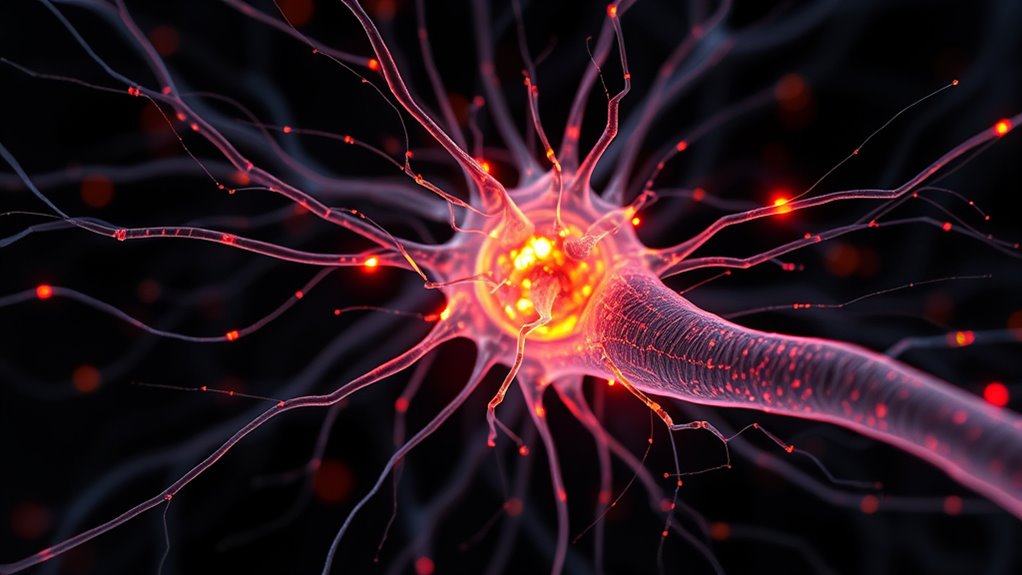
As blood vessels expand and press against surrounding nerves, they initiate a cascade of biochemical signals that activate nearby nerve endings. This process triggers neurogenic inflammation, where nerve activation releases neuropeptides like CGRP, substance P, and neurokinin A. These substances increase blood flow, promote plasma leakage, and recruit immune cells, amplifying inflammation. The resulting environment heightens nerve sensitivity, leading to sensory sensitization—your nerves become more responsive to stimuli. To visualize this, consider the following:
| Event | Effect | Outcome |
|---|---|---|
| Blood vessel dilation | Nerve activation | Neurogenic inflammation |
| Release of neuropeptides | Vasodilation & plasma leakage | Increased inflammation |
| Immune cell recruitment | Swelling & pain | Sensory sensitization |
| Enhanced nerve response | Lower pain threshold | More intense migraine pain |
| Persistent stimulation | Chronic sensitization | Longer-lasting symptoms |
Interaction Between CGRP and Other Neurotransmitters
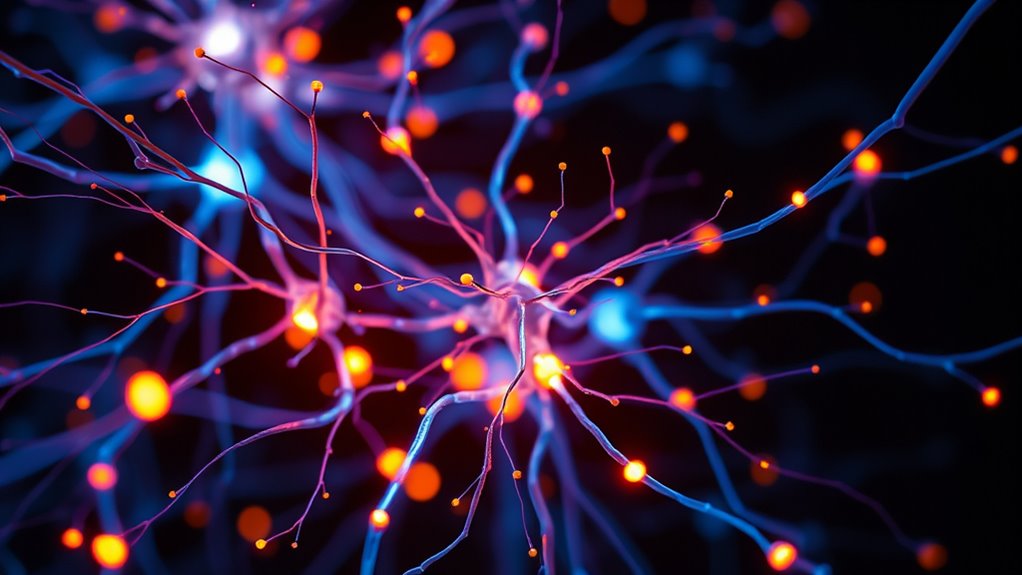
CGRP does not act alone in migraine pathophysiology; instead, it interacts with a complex network of neurochemicals that modulate pain signaling and inflammation. This neurotransmitter synergy enhances synaptic modulation, amplifying migraine pain. Here’s how it works:
- It increases the release of excitatory neurotransmitters like glutamate, heightening neuronal sensitivity.
- It interacts with serotonin, influencing vasodilation and pain pathways.
- It influences neuropeptides such as substance P, promoting inflammation.
- It affects GABA, potentially reducing inhibitory signals and worsening pain perception.
These interactions create a dynamic environment where CGRP collaborates with other neurotransmitters, intensifying migraine symptoms through complex synaptic modulation.
Genetic Factors Influencing CGRP Activity
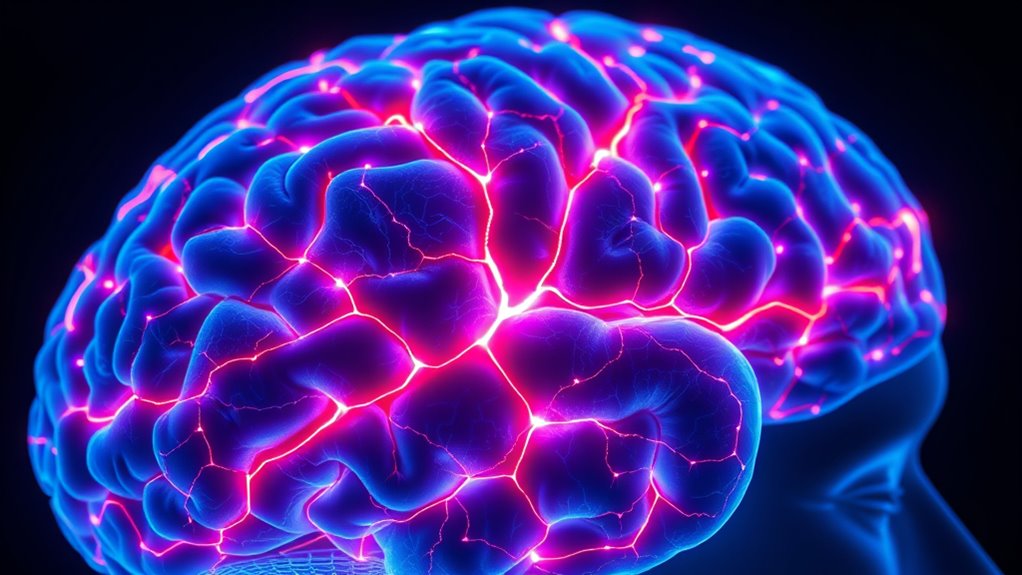
Genetic variations can markedly influence how CGRP functions in migraine sufferers. Your genetic predispositions can affect the likelihood of developing migraines by altering how genes related to CGRP are expressed. Variability in gene expression means that some individuals produce more CGRP or respond differently to its signaling, increasing their sensitivity to triggers. These differences can stem from mutations or polymorphisms in genes regulating CGRP synthesis, release, or receptor activity. Such genetic factors help explain why migraines run in families and why symptoms vary among individuals. Additionally, research into genetic factors can aid in developing personalized treatment approaches for migraine management. The presence of specific gene mutations may determine the effectiveness of targeted therapies that inhibit CGRP activity, emphasizing the importance of genetic testing in personalized medicine. Furthermore, understanding individual genetic profiles can help tailor preventive strategies and improve treatment outcomes.
Targeted Therapies Focused on CGRP Pathways

Have you ever wondered how targeted therapies can effectively prevent or treat migraines? These treatments focus on disrupting cgrp receptor signaling or regulating cgrp synthesis. They include:
- Monoclonal antibodies that block CGRP or its receptor, preventing signaling.
- Small-molecule antagonists (gepants) that inhibit cgrp receptor activity directly.
- CGRP synthesis inhibitors that reduce overall peptide production.
- Receptor-specific agents that fine-tune cgrp receptor signaling pathways.
Advances in CGRP-Related Diagnostic Techniques
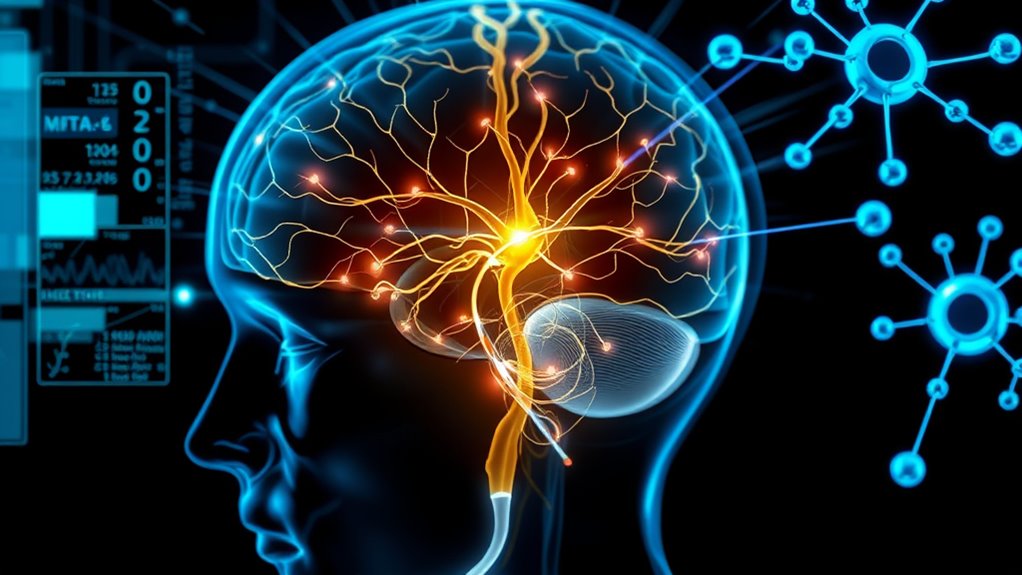
Recent advances in diagnostic techniques have enhanced our ability to detect and monitor CGRP-related activity in migraine patients. Biomarker discovery now offers promising avenues to identify CGRP levels accurately, aiding early diagnosis. Diagnostic imaging techniques, like functional MRI and PET scans, visualize CGRP-associated changes in the brain, providing real-time insights. These innovations can evoke hope, as shown in this table:
| Emotion | Impact |
|---|---|
| Hope | Early detection saves lives |
| Confidence | Personalized treatments |
| Relief | Better migraine management |
With these tools, you gain a clearer understanding of migraine mechanisms, paving the way for more precise interventions and improved patient outcomes.
Future Directions in Migraine Research and Treatment
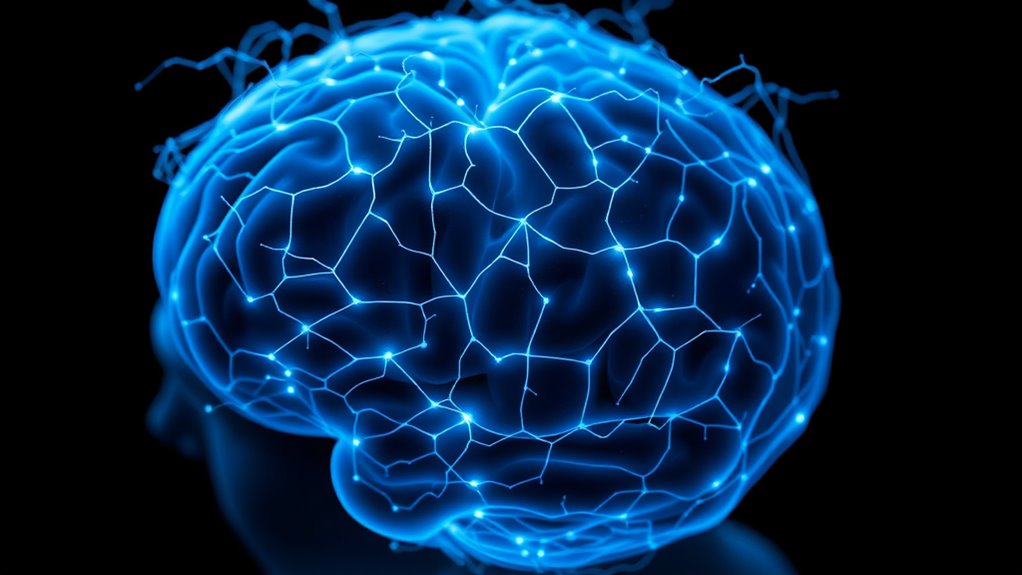
Looking ahead, you’ll see promising developments like novel CGRP antagonists that could improve migraine management. Researchers are also exploring personalized therapeutic strategies to tailor treatments to individual patients’ needs. These advancements have the potential to markedly enhance relief and quality of life for those affected. Additionally, insights into treatment delivery methods and technologies may inspire innovative approaches to optimize treatment delivery and patient engagement.
Novel CGRP Antagonists
Novel CGRP antagonists represent a promising frontier in migraine therapy, offering targeted mechanisms that can prevent or reduce attack frequency with fewer side effects. These cgrp receptor antagonists block CGRP activity, disrupting migraine pathways. Advances in peptide synthesis have enabled the development of potent, selective molecules. You can expect to see:
- Improved oral formulations for better patient compliance
- Enhanced selectivity reducing off-target effects
- Longer-lasting agents decreasing dosing frequency
- Potential for combination therapies with existing treatments
These innovations aim to optimize migraine management by precisely targeting CGRP pathways, minimizing adverse reactions. As research progresses, novel CGRP antagonists could revolutionize how you prevent and treat migraines, making therapy more effective and personalized.
Personalized Therapeutic Strategies
As research advances, personalized therapeutic strategies are becoming central to improving migraine management. You can identify specific dietary triggers that worsen your migraines and adjust your diet accordingly, reducing frequency and severity. Stress management techniques, like mindfulness or relaxation exercises, can help you better control triggers linked to stress. Tailoring treatments based on your unique patterns allows for more effective prevention and relief. For example, combining medication with lifestyle modifications such as avoiding certain foods or practicing stress reduction can markedly improve your quality of life. Future research aims to refine these approaches further, integrating genetic, environmental, and behavioral factors to develop customized plans. Understanding the safety features of various treatments ensures they are used effectively and minimizes risks. Incorporating knowledge of the underlying pathophysiology helps in designing more targeted and effective therapies. Additionally, advancements in automation technologies could facilitate personalized treatment monitoring and adjustment, leading to better patient outcomes. This personalized approach empowers you to take control of your migraines, minimizing their impact and enhancing overall well-being.
Frequently Asked Questions
How Do Lifestyle Factors Affect CGRP Levels During Migraines?
Lifestyle factors like stress management and sleep hygiene directly influence CGRP levels during migraines. When you manage stress effectively, you can reduce CGRP release, potentially decreasing migraine severity. Good sleep hygiene helps maintain stable CGRP levels, preventing triggers. By prioritizing relaxation techniques and regular sleep routines, you can lower the likelihood of CGRP spikes, ultimately minimizing migraine attacks and improving your overall well-being.
Are There Differences in CGRP Activity Among Various Migraine Subtypes?
Oh, the irony isn’t lost—different migraine types, yet they all seem to dance to CGRP’s tune. You might expect uniformity, but genetic variations shape distinct migraine phenotypes, influencing CGRP activity. Some subtypes, like aura migraines, show higher CGRP levels, while others don’t. So, yes, CGRP activity varies among migraine subtypes, reflecting underlying genetic differences that make each migraine a unique, personalized headache experience.
Can Dietary Interventions Influence CGRP Release or Function?
You might wonder if dietary interventions can influence CGRP release or function. Nutritional modulation, including specific dietary supplements, can impact migraine frequency and severity, potentially by affecting CGRP levels. Some supplements, like magnesium or riboflavin, may help regulate neurovascular responses. While more research is needed, adopting a balanced diet and considering targeted nutritional strategies could support your efforts to manage migraines by influencing CGRP activity.
How Does Age Impact Cgrp’s Role in Migraine Development?
Age-related changes can influence how CGRP contributes to migraines, as your body’s neurodegeneration impact alters nerve sensitivity and inflammatory responses. As you age, these changes may reduce CGRP’s role or modify its effects, potentially decreasing migraine frequency or intensity. Understanding this can help tailor treatments, since older individuals might respond differently to CGRP-targeted therapies, reflecting the complex interplay between aging and migraine mechanisms.
What Are Potential Side Effects of Cgrp-Targeted Therapies?
When considering CGRP-targeted therapies, you should be aware of potential side effects. These treatments may cause gastrointestinal disturbances like nausea or constipation, and some individuals could experience cardiovascular effects such as increased blood pressure or heart rate. While generally effective, it’s important to monitor for these reactions, especially if you have pre-existing conditions. Discuss any concerns with your healthcare provider to ensure safe and appropriate use.
Conclusion
As you delve into migraine research, remember CGRP’s pivotal role in shaping your understanding. Just like the alchemists sought to unlock hidden secrets, scientists now harness this knowledge to develop targeted treatments. By staying curious and embracing these advances, you can better manage migraines and improve lives. Keep in mind, the journey to relief is ongoing—what’s next might be as groundbreaking as discovering fire in the dark ages.
